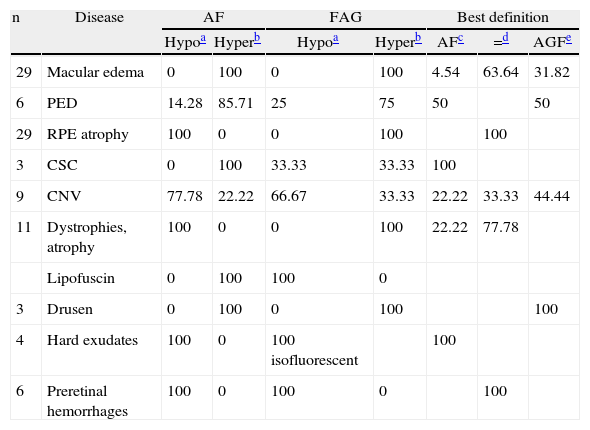To describe the findings of the study of autofluorescence of the different retinal diseases included in the study. To determine in which diseases autofluorescence may be more, or just as, useful as fluorescein angiography (FAG) in terms of diagnostic information.
Material and methodsWe studied the retinal autofluorescence of 123 eyes of 93 patients, including various diseases of the eye fundus. In all cases we explored the fundus, retinal autofluorescence, and, if indicated, FAG was performed. Analysis of the autofluorescence was performed using the Heidelberg Retina Angiograph 2 (HRA2) Heidelberg Engineering (Germany).
ResultsThe autofluorescence information provided was equal or better (than FAG) in: 68.18% of cases of macular edema, 50% of pigment epithelium detachments, 100% of pigment epithelium atrophies, 100% of central serous chorioretinopathy; 55.55% of choroidal neovascularization, 100% of retinal dystrophies with deposition of lipofuscin, 100% of hard exudates and pre-retinal hemorrhages.
ConclusionsAutofluorescence is a quick and non-invasive examination method, comfortable for both patient and examiner, and with a very short learning curve. It provides diagnostic information about many eye fundus diseases. While more studies and more experience with its use are needed, its interest lies in the possibility of avoiding the performing of angiography in patients with these diseases, and in the additional information autofluorescence provides about the functional situation of cells and retinal pigments.
Describir los hallazgos en el estudio de la autofluorescencia de las distintas enfermedades retinianas incluidas en el estudio. Estudiar en qué enfermedades la autofluorescencia puede ser igual o superior a la angiografía fluoresceínica (AGF) en cuanto a información diagnóstica.
Material y métodosSe estudió la autofluorescencia retiniana de 123 ojos y pacientes, incluyendo diversas enfermedades del fondo de ojo. En todos los casos se exploró el fondo de ojo, la autofluorescencia retiniana, y, en caso de estar indicado, se realizó AGF. La exploración de la autofluorescencia fue llevada a cabo usando el angiógrafo Heidelberg Retina Angiograph 2 (HRA2) de Heidelberg Engeneering (Alemania).
ResultadosLa autofluorescencia aportó una información igual o mejor (que la AGF) en: 68,18% de casos de edema macular; 50% de desprendimientos del epitelio pigmenario; 100% de atrofias del epitelio pigmentario; 100% de coriorretinopatías centrales serosas; 55,55% de neovascularizaciones coroideas; 100% de las distrofias retinianas con depósito de lipofucsina; 100% de los exudados duros y hemorragias prerretinianas.
ConclusionesLa autofluorescencia es un método de exploración rápido, cómodo para el paciente y explorador, no invasivo y con una curva de aprendizaje muy corta, que aporta información para el diagnóstico de múltiples enfermedades con afectación del fondo de ojo. Si bien son precisos más estudios y más experiencia con su uso, su interés radica en la posibilidad de evitar la realización de angiografías en pacientes con estas enfermedades y en la información adicional que nos aporta sobre la situación funcional de las células y pigmentos retinianos.












